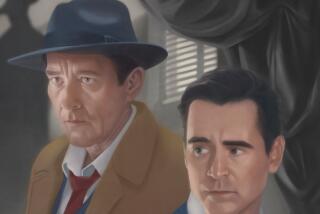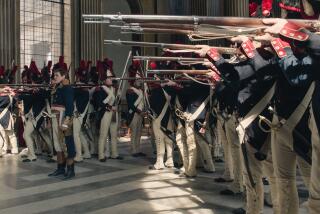‘Napoleon and Josephine’: French History Goes Bust
- Share via
ABC unveils a version of French history tonight that locates a middle ground between Inspector Clouseau and Benny Hill.
The staging is grand and the costumes colorful. What stands out most in “Napoleon and Josephine: A Love Story,” though, are the breasts.
Jacqueline Bisset as Josephine and Stephanie Beacham as her bawdy girlfriend, Therese, present a cluster of cleavage that is truly stunning by prime-time standards. No wonder that Armand Assante’s Napoleon is mad-- mad , do you hear!--with lust and passion.
Prime time has obviously come of age. If not for its attention to human physiography, “Napoleon and Josephine” (9 p.m. tonight through Thursday on Channels 7, 3, 10 and 42) would be a blubbering bore. Much of it is, anyway.
The nickname given the French statesman Talleyrand--”a silk stocking filled with mud”--also applies to “Napoleon and Josephine.”
The year is 1794, when the new order is still consolidating its power via the guillotine in post-revolutionary France. We first meet Josephine Beauharnais as she is in a cell, awaiting execution, anxious to exchange even her virtue (gulp) for her freedom. Meanwhile, Napoleon Bonaparte is a 25-year-old general who is arrested when he offends the government leader Robespierre. When Robespierre falls, Napoleon and Josephine are freed.
And their love story--from courtship to marriage to divorce--begins to unfold. Some highlights:
“That’s the most beautiful woman I’ve ever seen,” Napoleon says when he first sets eyes on Josephine. For their first quasi-date, Josephine wears a gown “with nothing underneath.” When she testily asks Napoleon if others have told him the location of her beauty marks, he replies: “As a soldier, I prefer personal reconnaissance.” No wonder that Josephine soon concludes about Napoleon: “He’s like a force of nature.”
Napoleon’s family doesn’t care for Josephine a whit, unfortunately. She gets only sneers from his mother, who knew Napoleon would make it big “from the moment he was conceived in my womb.” That’s early. And his brother says about Josephine: “She’s a female skilled in the arts of passion.”
Josephine is slow to warm to Napoleon, so they don’t hit the sack until the beginning of the second hour (while the camera focuses on a pair of burning candles).
Bisset is credible as a sympathetic Josephine, unable to bear Napoleon the heir he desires. On the other hand, Assante is the screen’s second Napoleon who sounds like Rod Steiger (the first was Steiger himself in 1971’s “Waterloo”). You can picture this Bonaparte beside Marlon Brando in the back seat of that car in “On the Waterfront.” (Brando was less than memorable himself as a love-smitten Napoleon in the 1954 movie “Desiree.”)
Meanwhile, director Richard T. Heffron mounts some nice battle sequences in “Napoleon and Josephine.” And in a broad sense, the story is accurate. Napoleon and Josephine existed. So did Viscount Paul Francois Jean Nicholas de Barras (Jean-Pierre Stewart), Talleyrand (Anthony Perkins) and spectacular bosoms.
James Lee’s script is heavy on hot-breathed romance, though--offering little sense of history or Napoleon’s genius. Napoleon’s campaigns abroad seem rather disjointed and trivial compared with his obsession for the home front, where Josephine’s affair with a young officer drives Napoleon mad. Do you hear, mad !
The David L. Wolper production carries the standard disclaimer that “certain events and characters have been fictionalized.” A lot of good that does. In such cases, exactly which events and characters are untrue should be listed at the bottom of the credits. Awkward, but fair.
Not that the merging of reality and fantasy here is always subtle. Get ready for one gorgeously junky and melodramatic scene where Napoleon emerges from a seizure just in time to attempt saving Josephine’s lover from a firing squad.
Then he takes his army to Egypt.
A soldier, a lover, a force of nature.
More to Read
The complete guide to home viewing
Get Screen Gab for everything about the TV shows and streaming movies everyone’s talking about.
You may occasionally receive promotional content from the Los Angeles Times.






